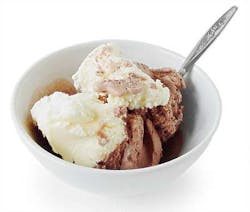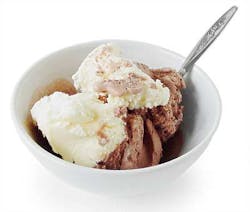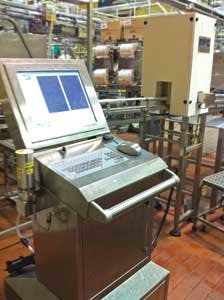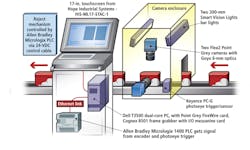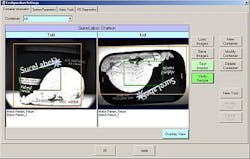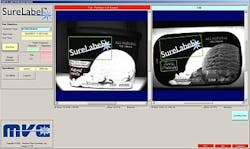Sweet Success
Ice cream label-checking system relies on off-the-shelf machine-vision components to ensure accurate packaging
Winn Hardin, Contributing Editor
A major US manufacturer of ice cream wanted to limit its liability and protect its customers from surprise allergic reactions caused by the wrong ice cream going into the wrong tub or closed with the wrong lid. The food producer turned to machine-vision integrator Machine Vision Consulting, which developed a label-checking system that would check both the label on the side of the squared off/round (or “sqround”) shaped container and the label on the top of the container, and compare those findings to a recipe selected by the production line operator.
The solution, which is now a turnkey system sold under the name of SureLabel, is based on a pair of Point Grey Research Flea2 cameras, a Cognex 8501 frame grabber with 24-V I/O daughter card, Smart Vision Lights bar lights, and Cognex VisionPro image-processing software in a PC. The PC sends fail signals to a nearby Allen Bradley Micrologix programmable logic controller (PLC) that controls a reject mechanism.
No allergic reaction
“The customer came to us and was nervous about its customers possibly having an allergic reaction to an ingredient in the ice cream because of improper labeling,” explains Jeffrey Dannay, president of Machine Vision Consulting. “So we designed a system that would look at the artwork on both the top and the side of the sqround with an easy-to-use recipe storage and retrieval system. They really liked the recipe system because it was very easy to train, which is important when you make hundreds of different flavors of ice cream, each with different labels and artwork.”
He said that the recipe system also made it easy to choose the flavor and, therefore, the inspection routine using menus or a handheld barcode scanner. The operator can simply scan the barcode on the side of the sqround with a barcode or Data Matrix reader, and the software automatically loads the right inspection routine into the SureLabel system.
The ice cream label-inspection system was a retrofit to existing production equipment. Dannay designed the system to easily integrate with existing conveyors and networks as necessary but also to work in standalone mode, depending on the customer’s needs. For the ice cream inspection application, the customer wanted Dannay’s company to install the label checker at a small facility near MVC’s Boston-area headquarters. Now that the system has proven itself, MVC plans to move the system to a larger ice cream manufacturing plant in Indiana as the first of 20 such installations for the customer.
Sqround imaging
The SureLabel system is designed in three parts: an enclosure for the camera, optics, lights, and photoeye trigger; followed by a rejector mechanism and accumulator; and concluding with the computer station, which also holds the Allen Bradley Micrologix PLC (see Fig. 1).
The conveyor that carries the ice cream sqrounds is only wide enough to allow the containers to pass length-wise through the camera enclosure for inspection. Because the sqrounds are all facing the same direction, system designers could inspect the containers using only two Point Grey Flea2 cameras: one for the top, the other for the side (or front) of the container.
“We chose the Flea2 because of its small size [29 × 29 × 30 mm] and the ability to fit with the Goyo 6-mm, 2/3-in. sensor lens in a compact Allison Park Group stainless-steel enclosure,” explains Dannay. “This is a food-processing operation and, therefore, needs to be washdown ready and comply with 21 CFR Part 11.” 21 CFR Part 11 comprises US government regulations that target pharmaceutical production systems. These regulations—which are designed to document production equipment operation to improve quality, limit liability, and aid companies in the event of a recall—are used increasingly by the food-processing industry (see Fig. 2).
Dannay adds that he also wanted to go with the Flea2 FireWire camera because FireWire and Gigabit Ethernet cameras can easily scale up to larger numbers. Adding analog cameras, while cheaper in the short run, will eventually necessitate additional frame grabbers, adding cost and complexity to the label inspection system.
MVC chose to use a Cognex 8501 frame grabber with optoisolated I/O mezzanine card even though they did not plan to use a frame grabber except for I/O. “We did it because it made it easier to integrate the VisionPro image-processing library into the system,” says Dannay. “We are very familiar with the VisionPro software and use it when we can.”
In addition to the two Flea2 cameras, each in their own APG stainless-steel housing, the camera enclosure also includes a pair of Smart Vision Lights 300-mm bar lights. “These lights are connected directly to a power supply and not to the PC for control and they are the best when it comes to washdown compliance, operation, and cost,” Dannay says.
“We don’t actually point them at the product. Instead, we point them at diffusing panels on the inside walls of the stainless-steel camera enclosure to provide a bright, even light throughout the camera enclosure. The strobe controller is embedded within the light and is controlled (signaled) directly from the camera.”
As the sqround passes into the camera enclosure, it breaks the beam from a Keyence PC-G retroreflective photoeye sensor. The 24-VDC signal is sent to the optoisolated I/O card on the Cognex 8501 frame grabber to begin the image acquisition and inspection procedure (see Fig. 3).
The VisionPro software triggers the two Flea2 cameras to acquire a 2-Mpixel image of the ice cream container and sends the image across the 1394b connection to the PC’s memory, where the image-processing algorithms take over (see Fig. 4).
“VisionPro has all the most common algorithms,” says Dannay, “but we typically only use a few algorithms for the application software, depending on what the customer needs. They want to be able to train the system on new product without having to understand the underlying algorithms. With that in mind, we typically supply barcode and Data Matrix reading tools; edge tools to check label skew; and PatMax to do geometric pattern searches of the artwork that identifies the ice cream flavor.
“We also included a histogram tool because this system can look at color variation, too, although this client isn’t using that functionality today,” he notes. “Then we label the algorithms in ways the customer will understand. For instance, they don’t want a barcode or Data Matrix tool, they want a UPC lookup tool because that’s the language they’re used to. In other cases, we may knit two or three image-processing algorithms together to do a specific function for the customer.”
After VisionPro has analyzed the images and compared the findings to skew settings and the recipe set by the production operator, the PC sends a pass/fail message across an Ethernet connection to a neighboring Micrologix 1400 PLC located inside the same stainless-steel enclosure as the PC and Hope Industrial Systems 17-in. touchscreen display (see Fig. 4).
In addition to controlling the downstream reject actuator, the PLC also tracks the movement of each carton as it passes through the inspection work cell based on readings from the BEI hollow shaft Optical Express encoder. When a failed container reaches the reject mechanism, the PLC sends a 24-VDC signal to the actuator, and the carton is plucked from the line.
“When we move this system to the larger facility in Indiana, we expect to connect the system to the plant network to automate the recipe selection and reduce the need for operator oversight,” explains MVC’s Dannay. “The system’s a ‘go,’ we’re just waiting on the customer.”
Company Info
Allen Bradley, Milwaukee, WI, USA
Allison Park Group, Allison Park, PA, USA
BEI Industrial Encoders, Goleta, CA, USA
Cognex, Natick, MA, USA
Goyo Optical, Asaka, Japan
Hope Industrial Systems, Roswell, GA, USA
Keyence Corporation of America, Woodcliff Lake, NJ, USA
Machine Vision Consulting, Westborough, MA, USA
Point Grey Research, Richmond, BC, Canada
Smart Vision Lights, Muskegon, MI, USA
Vision Systems Articles Archives
